The Use of the Kahoot! Learning Platform as a Type of Formative Assessment in the Context of Pre-University Education during the COVID-19 Pandemic Period
Abstract
:1. Introduction
2. Materials and Methods
- Step 1: A study was conducted on the standardized Kahoot! interactive exercise feedback assessments for all classes in the online teaching–learning–assessment model over five weeks of school.
- Step 2: A study of the standardized feedback and final review assessments was conducted on the Kahoot! learning platform for all classes in a traditional teaching–learning–assessment model during six weeks of school.
- Step 3: Conduct, complete, and analyze the Google Forms questionnaire for student perception of the interactive game Kahoot! for the feedback/summative assessment sequence in geography lessons.
3. Results
4. Discussion
5. Conclusions
Author Contributions
Funding
Institutional Review Board Statement
Informed Consent Statement
Data Availability Statement
Conflicts of Interest
References
- Muzammal, A.K. COVID-19’s Impact on Higher Education: A Rapid Review of Early Reactive Literature. Educ. Sci. 2021, 11, 421. [Google Scholar] [CrossRef]
- Bornert-Ringleb, M.; Casale, G.; Hillenbrand, C. What predicts teachers’ use of digital learning in Germany? Examining the obstacles and conditions of digital learning in special education. Eur. J. Spec. Needs Educ. 2021, 36, 80–97. [Google Scholar] [CrossRef]
- Mehrvarz, M.; Heidari, E.; Farrokhnia, M.; Noroozi, O. The mediating role of digital informal learning in the relationship between students’ digital competence and their academic performance. Comput. Educ. 2021, 167, 104–184. [Google Scholar] [CrossRef]
- Abdulrahim, H.; Mabrouk, F. COVID-19 and the Digital Transformation of Saudi Higher Education. Asian J. Distance Educ. 2020, 15, 291–306. [Google Scholar]
- Skulmowski, A.; Rey, G.D. COVID-19 as an Accelerator for Digitalization at a German University: Establishing Hybrid Campuses in Times of Crisis. Hum. Behav. Emerg. Technol. 2020, 2, 212–216. [Google Scholar] [CrossRef] [PubMed]
- Rajhans, V.; Memon, U.; Patil, V.; Goyal, A. Impact of COVID-19 on Academic Activities and Way Forward in Indian Optometry. J. Optom. 2020, 13, 216–226. [Google Scholar] [CrossRef] [PubMed]
- Zainuddin, Z.; Perera, C.J.; Haruna, H.; Habiburrahim, H. Literacy in the New Norm: Stay-Home Game Plan for Parents. Inf. Learn. Sci. 2020, 121, 645–653. [Google Scholar] [CrossRef]
- Jayathirtha, G.; Fields, D.; Kafai, Y.B.; Chipps, J. Supporting Making Online: The Role of Artifact, Teacher and Peer Interactions in Crafting Electronic Textiles. Inf. Learn. Sci. 2020, 121, 381–390. [Google Scholar] [CrossRef]
- Mailizar; Almanthari, A.; Maulina, S.; Bruce, S. Secondary School Mathematics Teachers’ Views on e-Learning Implementation Barriers during the COVID-19 Pandemic: The Case of Indonesia. Eurasia J. Math. Sci. Technol. Educ. 2020, 16, em1860. [Google Scholar] [CrossRef]
- Murphy, M.P.A. COVID-19 and emergency eLearning: Consequences of the securitization of higher education for post-pandemic pedagogy. Contemp. Secur. Policy 2020, 1–14. [Google Scholar] [CrossRef]
- Zhou, L.; Wu, S.; Zhou, M.; Li, F. ‘School’s Out, But Class’ On’, The Largest Online Education in the World Today: Taking China’s Practical Exploration During The COVID-19 Epidemic Prevention and Control as an Example. Best Evid. Chin. Edu. 2020, 4, 501–519. [Google Scholar] [CrossRef]
- Demuyakor, J. Coronavirus (COVID-19) and Online Learning in Higher Institutions of Education: A Survey of the Perceptions of Ghanaian International Students in China. Online J. Commun. Media Technol. 2020, 10, 3. [Google Scholar] [CrossRef]
- Sosa Diaz, M.J.; Antequera, J.G.; Pizzaro, M.C. Flipped Classroom in the Context of Higher Education: Learning, Satisfaction and Interaction. Educ. Sci. 2021, 11, 416. [Google Scholar] [CrossRef]
- Ilovan, O.R. Feedforward for University Geographical Online Education during the COVID-19 Pandemic. In Proceedings of the International Conference on Virtual Learning, Virtual. 20–22 July 2021; pp. 76–85. [Google Scholar]
- Borza, M.; Park, J.O. Facing the University Environment with Covid-19 Pandemic: A Comparative Analysis between Romania and South Korea. Rom. Mag. Multidimens. Educ. 2020, 12, 34–38. [Google Scholar]
- Sánchez-Ruiz, L.M.; Moll-López, S.; Moraño -Fernández, J.A.; Llobregat-Gómez, N. B-Learning and Technology: Enablers for University Education Resilience an Experience Case under COVID-19 in Spain. Sustainability 2021, 13, 3532. [Google Scholar] [CrossRef]
- Perez-Mora, R.; Arellano, C.I.M. Student perceptions, from their diversity, on the effects of the transition to online modality in the context of the COVID-19 pandemic. Rev. Iberoam. Educ. 2021, 86, 147–169. Available online: https://pesquisa.bvsalud.org/global-literature-on-novel-coronavirus-2019-ncov/resource/pt/covidwho-1378525 (accessed on 18 October 2021).
- Flynn, N.; Keane, E.; Davitt, E.; McCauley, V.; Heinz, M.; Mac Ruairc, G. Schooling at Home ‘in Ireland during COVID-19: Parents’ and Students’ Perspectives on Overall Impact, Continuity of Interest, and Impact on Learning. Ir. Educ. Stud. 2021, 40, 217–226. [Google Scholar] [CrossRef]
- Liu, O.L.; Bridgeman, B.; Adler, R.M. Measuring learning outcomes in higher education: Motivation matters. Educ. Res. 2012, 41, 352–362. [Google Scholar] [CrossRef] [Green Version]
- Baker, R.S.J.D.; D’Mello, S.K.; Rodrigo, M.M.T.; Graesser, A.C. Better to be frustrated than bored: The incidence, persistence, and impact of learners’ cognitive–affective states during interactions with three different computer-based learning environments. Int. J. Hum.-Comput. Stud. 2010, 68, 223–241. [Google Scholar] [CrossRef] [Green Version]
- Butler, J.A. Use of teaching methods within the lecture format. Med. Teach. 1992, 14, 11–25. [Google Scholar] [CrossRef] [PubMed]
- Murray, H.G. Effective teaching behaviors in the college classroom. High. Educ. Handb. Theory Res. 1991, 7, 135–172. [Google Scholar]
- Hattie, J.A.C. Visible Learning for Teachers—Maximizing Impact on Learning; Routledge: New York, NY, USA, 2012. [Google Scholar]
- Sebastiá-Alcaraz, R.; Monllor, E.M. Geoinformation for democratic memory. Cuadernos Geograficos. 2020, 59, 129–148. [Google Scholar]
- Cheung, R.; Vogel, D. Predicting user acceptance of collaborative technologies: An extension of the technology acceptance model for e-learning. Comput. Educ. 2013, 63, 160–175. [Google Scholar] [CrossRef]
- Gee, J.P. What video games have to teach us about learning and literacy. Comput. Entertain. 2003, 1, 20. [Google Scholar] [CrossRef]
- Sharples, M. The design of personal mobile technologies for lifelong learning. Comput. Educ. 2000, 34, 177–193. [Google Scholar] [CrossRef]
- What is Kahoot!? Available online: https://kahoot.com/what-is-kahoot/ (accessed on 12 August 2021).
- Zhang, Q.; Yu, Z.G. A literature review on the influence of Kahoot! On learning outcomes, interaction, and collaboration. Educ. Inf. Technol. 2021, 26, 4507–4535. [Google Scholar] [CrossRef]
- Wang, A.I.; Tahir, R. The effect of using Kahoot! for learning—A literature review. Comput. Educ. 2020, 149, 103818. [Google Scholar] [CrossRef]
- Wang, A.I. The wear out effect of a game-based student response system. Comput. Educ. 2015, 82, 217–227. [Google Scholar] [CrossRef] [Green Version]
- Kay, R.H.; LeSage, A. Examining the benefits and challenges of using audience response systems: A review of the literature. Comput. Educ. 2009, 53, 819–827. [Google Scholar] [CrossRef]
- Wang, A.I.; Lieberoth, A. The effect of points and audio on concentration, engagement, enjoyment, learning, motivation, and classroom dynamics using Kahoot! In Proceedings from the 10th European Conference of Games Based Learning, Paisleym, UK, 6–7 October 2016; Academic Conferences and Publishing International Limited, 10th European Conference on Game Based Learning (ECGBL 2016): Paisley, Scotland, UK, 2016. [Google Scholar]
- Iwamoto, D.H.; Hargis, J.; Taitano, E.J.; Vuong, K. Analyzing the efficacy of the testing effect using KahootTM on student performance. Turk. Online J. Distance Educ. 2017, 18, 80–93. [Google Scholar]
- Bicen, H.; Kocakoyun, S. Perceptions of students for gamification approach: Kahoot as a case study. Int. J. Emerg. Technol. Learn. (iJET) 2018, 13, 72–93. [Google Scholar] [CrossRef] [Green Version]
- Plump, C.M.; LaRosa, J. Using Kahoot! In the classroom to create engagement and active learning: A game-based technology solution for elearning novices. Manag. Teach. Rev. 2017, 2, 151–158. [Google Scholar] [CrossRef]
- Dolezal, D.; Posekany, A.; Motschnig, R.; Pucher, R. Effects of introducing a game-based student response system into a flipped, person-centered classroom on object-oriented design. In International Conference on Web-Based Learning; Springer: Berlin/Heidelberg, Germany, 2018; pp. 132–139. [Google Scholar]
- Guo, W.Y.; Yan, Z. Formative, and summative assessment in Hong Kong primary schools: Students’ attitudes matter. Assess. Educ.-Princ. Policy Pract. 2019, 26, 675–699. [Google Scholar] [CrossRef]
- Leenknecht, M.; Wijnia, L.; Kohlen, M.; Fryer, L.; Rikers, R.; Loyens, S. Formative assessment as practice: The role of students’ motivation. Assess. Eval. High. Educ. 2021, 46, 236–255. [Google Scholar] [CrossRef]
- Perry, A.; Karpova, E. Efficacy of Teaching Creative Thinking Skills: A Comparison of Multiple Creativity Assessments. Think. Ski. Creat. 2017, 24, 118–126. [Google Scholar] [CrossRef]
- Webb, M.E. Affordances of ICT in science learning: Implications for an integrated pedagogy. Int. J. Sci. Educ. 2005, 27, 705–735. [Google Scholar] [CrossRef]
- Alqahtani, A.Y.; Rajkhan, A.A. E-Learning Critical Success Factors during the COVID-19 Pandemic: A Comprehensive Analysis of E-Learning Managerial Perspectives. Educ. Sci. 2020, 10, 216. [Google Scholar] [CrossRef]
- Nikou, S.; Maslov, I. An analysis of students’ perspectives on e-learning participation—The case of COVID-19 pandemic. Int. J. Inf. Learn. Technol. 2021, 38, 299–315. [Google Scholar] [CrossRef]
- Yakut, A.D. Educators’ experiences in special education institutions during the COVID-19 outbreak. J. Res. Spec. Educ. Needs 2021, 1–10. [Google Scholar] [CrossRef]
- Nepal, R.; Ann, M.R. From Theory to Practice of Promoting Student Engagement in Business and Law-Related Disciplines: The Case of Undergraduate Economics Education. Educ. Sci. 2020, 10, 205. [Google Scholar] [CrossRef]
- Braghină, C.; Peptenatu, D.; Draghici, C.C.; Pintilii, R.D.; Schvab, A. Territorial Management within the Systems Affected by Mining. Case study The South-Western Development region in Romania. Iran. J. Environ. Health Sci. Eng. 2011, 8, 343–352. [Google Scholar]
- Peptenatu, D.; Merciu, C.; Merciu, G.; Draghici, C.C.; Cercleux, L. Specific features of environment risk management in emerging territorial Structures. Carpathian J. Earth Environ. Sci. 2012, 7, 135–143. [Google Scholar]
- Pintilii, R.D.; Andronache, I.; Simion, A.G.; Draghici, C.C.; Peptenatu, D.; Ciobotaru, A.M.; Dobrea, R.C.; Papuc, R.M. Determining forest fund evolution by fractal analysis (Suceava-Romania). Urban. Archit. Constr. 2016, 7, 31–42. [Google Scholar]
- Draghici, C.C.; Peptenatu, D.; Simion, A.G.; Pintilii, R.D.; Diaconu, D.C.; Teodorescu, C.; Papuc, R.M.; Grigore, A.M.; Dobrea, C.R. Assessing economic pressure on the forest fund of Maramures County Romania. J. For. Sci. 2016, 62, 175–185. [Google Scholar]
- Pravalie, R.; Patriche, C.V.; Sirodoev, I.; Bandoc, G.; Dumitrescu, M.; Peptenatu, D. Water deficit and corn productivity during the post-socialist period. Case study: Southern Oltenia drylands, Romania. Arid Land Res. Manag. 2016, 30, 239–257. [Google Scholar] [CrossRef]
- Pintilii, R.D.; Andronache, I.; Diaconu, D.C.; Dobrea, R.C.; Zelenakova, M.; Fensholt, R.; Peptenatu, D.; Draghici, C.C.; Ciobotaru, A.M. Using Fractal Analysis in Modeling the Dynamics of Forest and Economic Impact Assessment: Maramureș County, Romania, as a Case Study. Forests 2017, 8, 25. [Google Scholar] [CrossRef] [Green Version]
- Draghici, C.C.; Andronache, I.; Ahammer, H.; Peptenatu, D.; Pintilii, R.D.; Ciobotaru, A.M.; Simion, A.G.; Dobrea, R.C.; Diaconu, D.C.; Vişan, M.C.; et al. Spatial evolution of forest areas in the Northern Carpathian Mountains of Romania. Acta Montan. Slovaca 2017, 22, 95–106. [Google Scholar]
- Diaconu, D.C.; Peptenatu, D.; Simion, A.G.; Pintilii, R.D.; Draghici, C.C.; Teodorescu, C.; Grecu, A.; Gruia, A.K.; Ilie, A.M. The restrictions imposed upon the urban development by the piezometric level. Case study: Otopeni-Tunari, Corbeanca. Urban. Arhit. Constr. 2017, 8, 27–36. [Google Scholar]
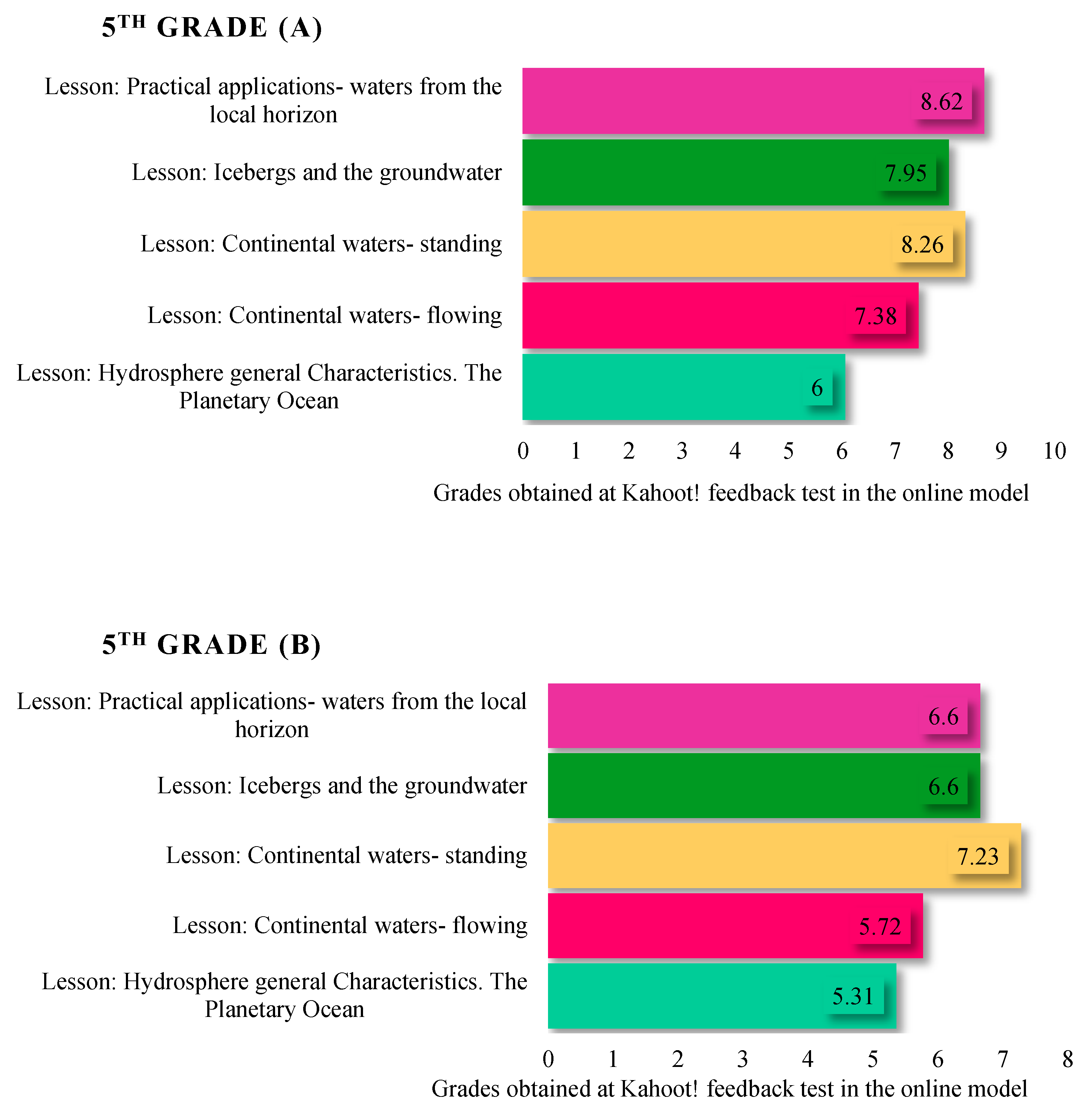
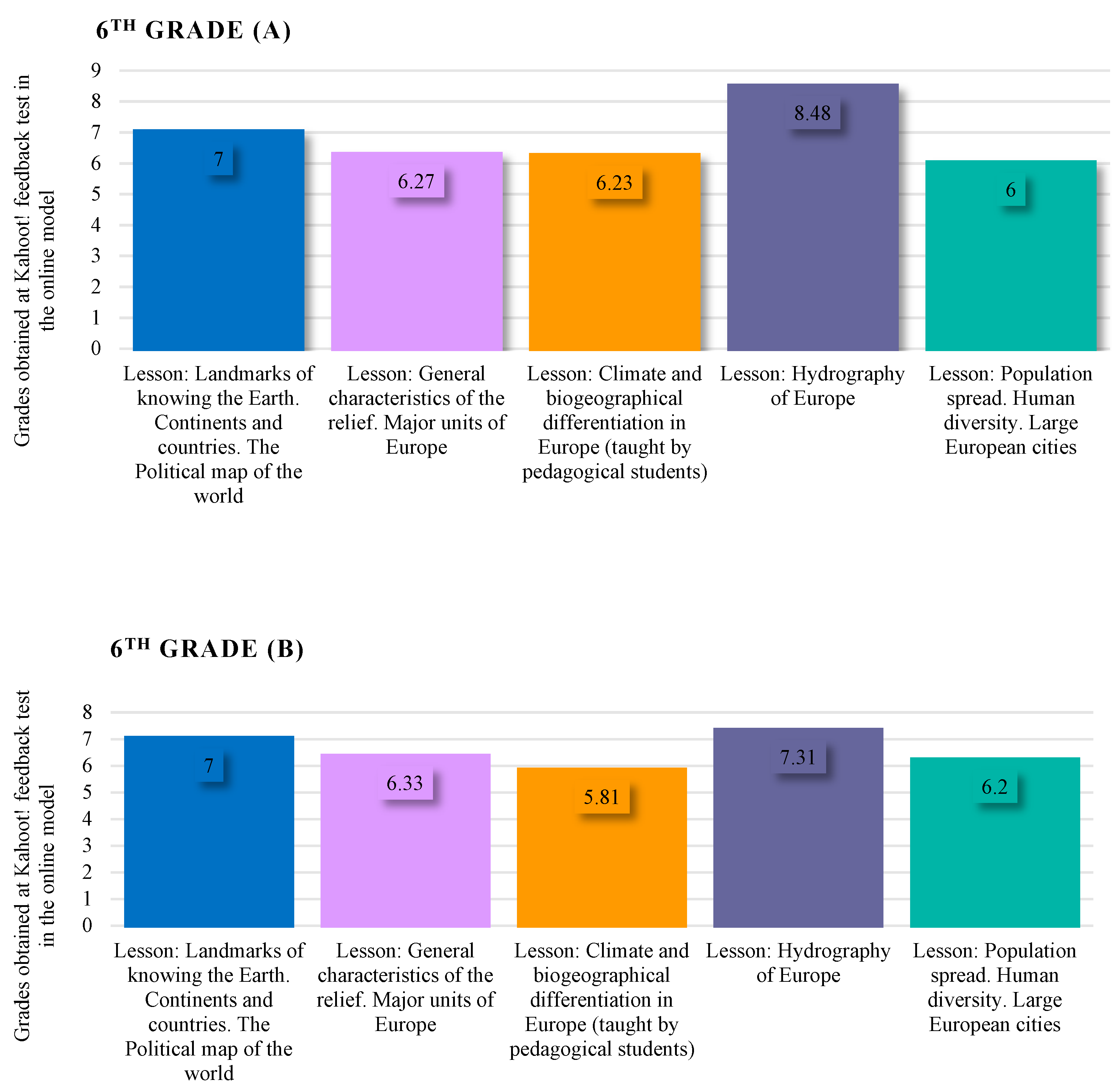
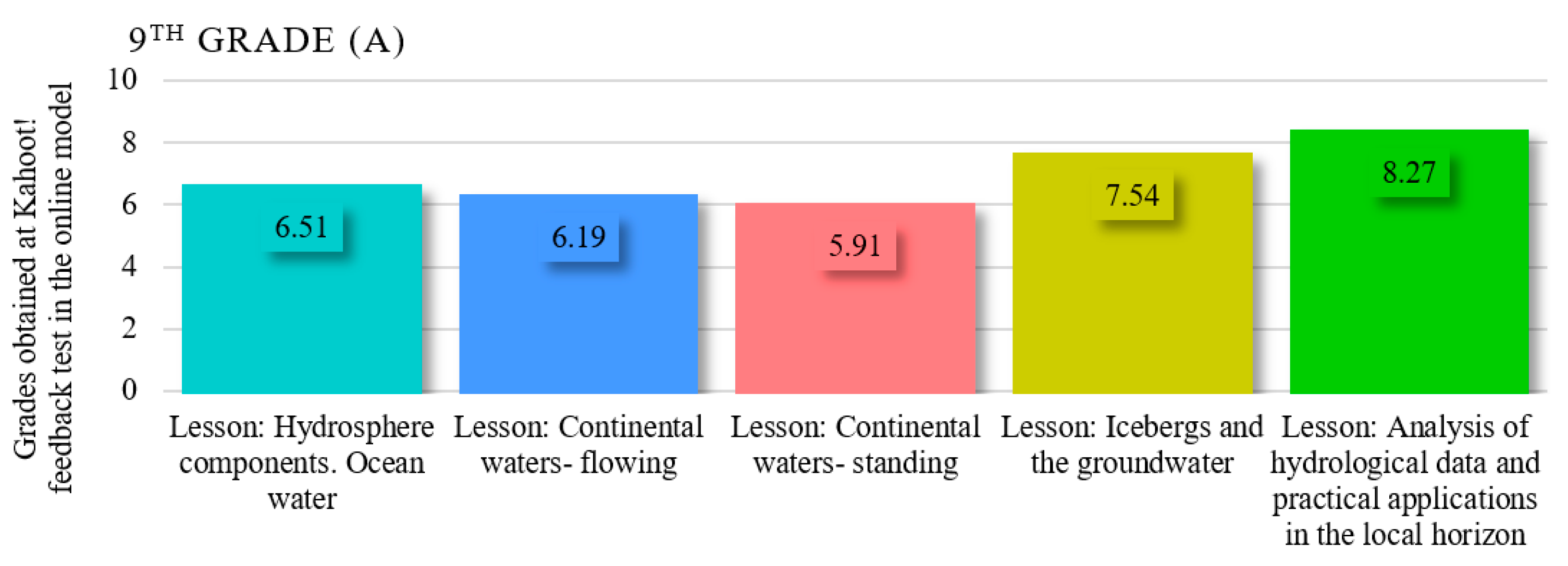
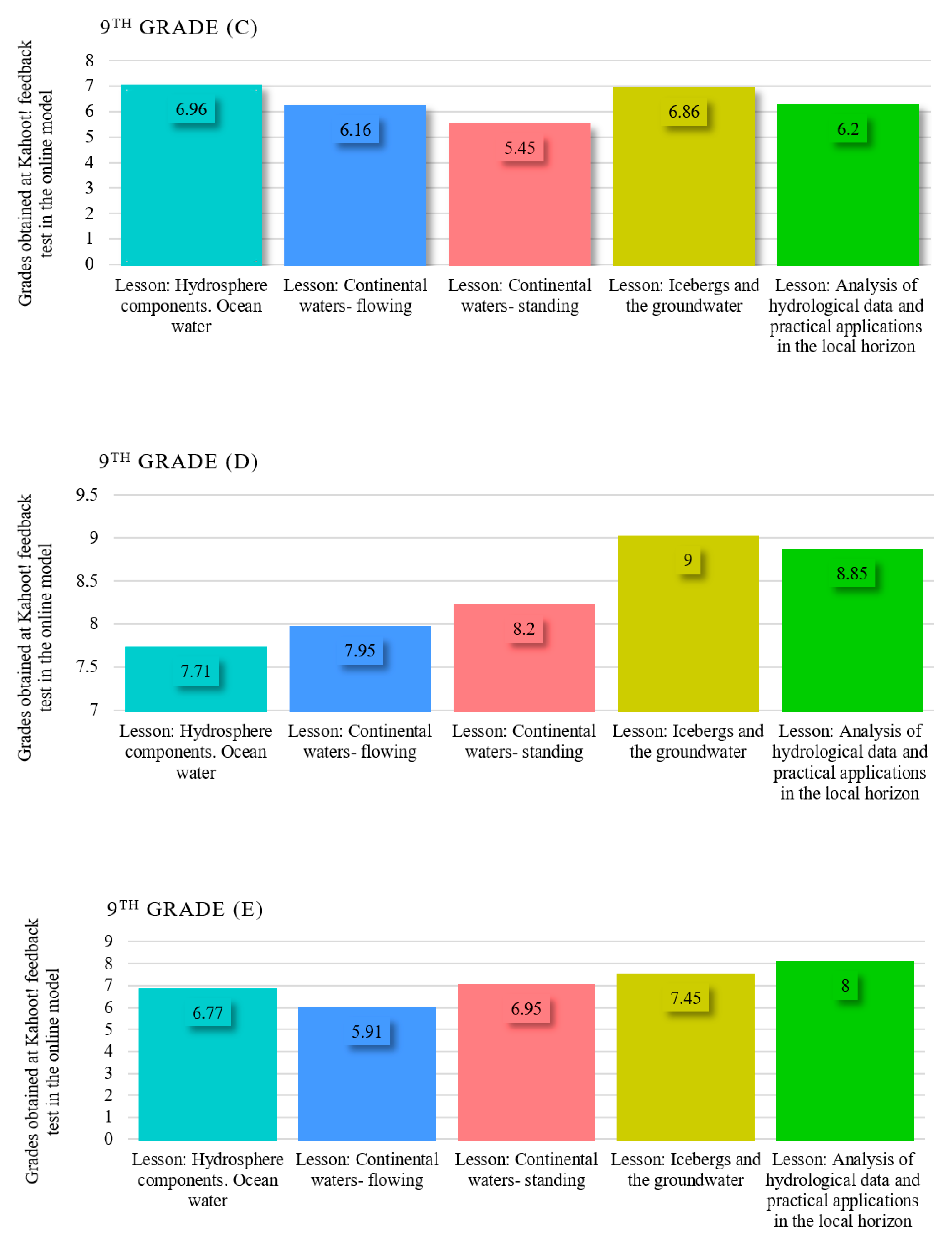


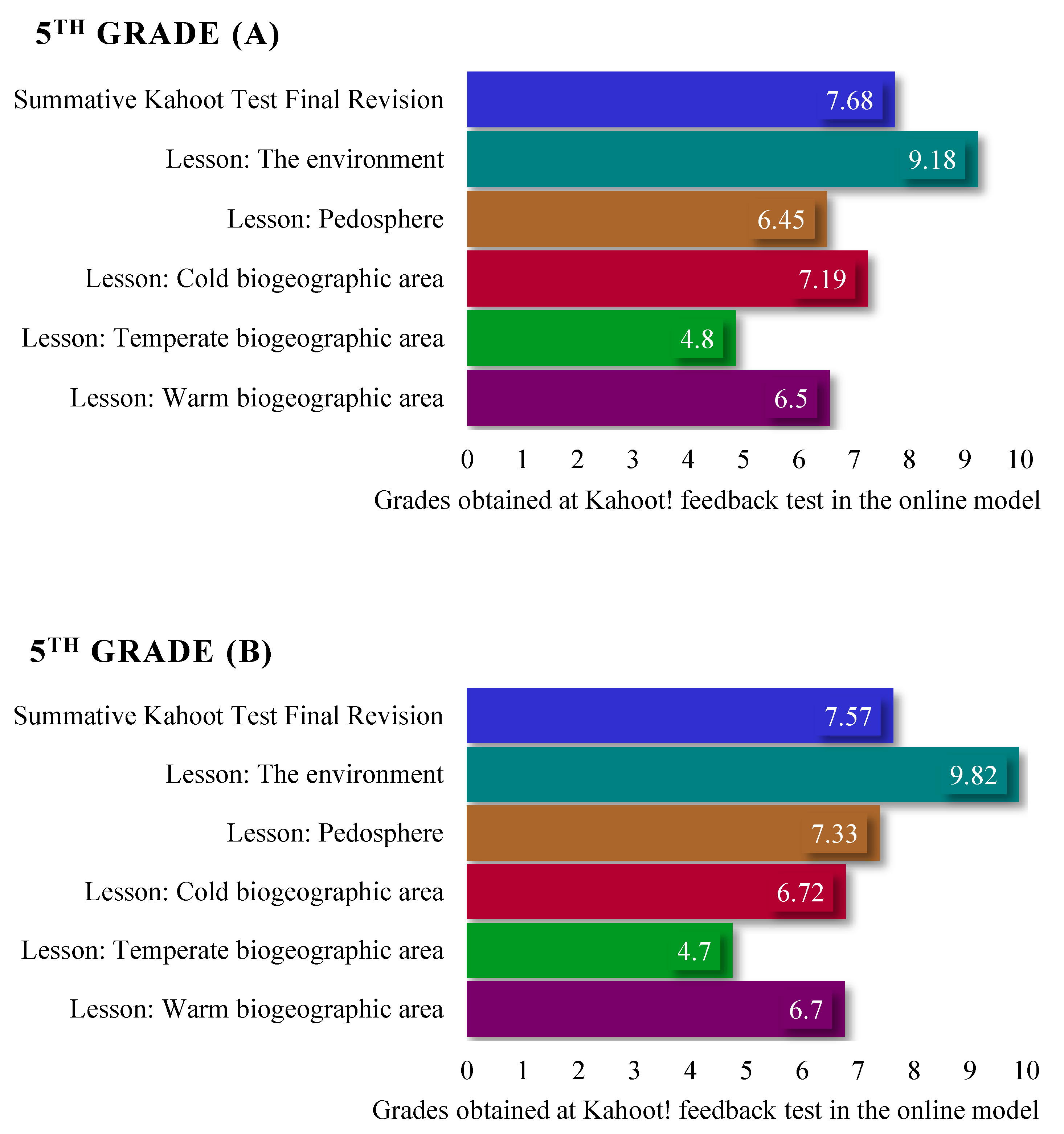

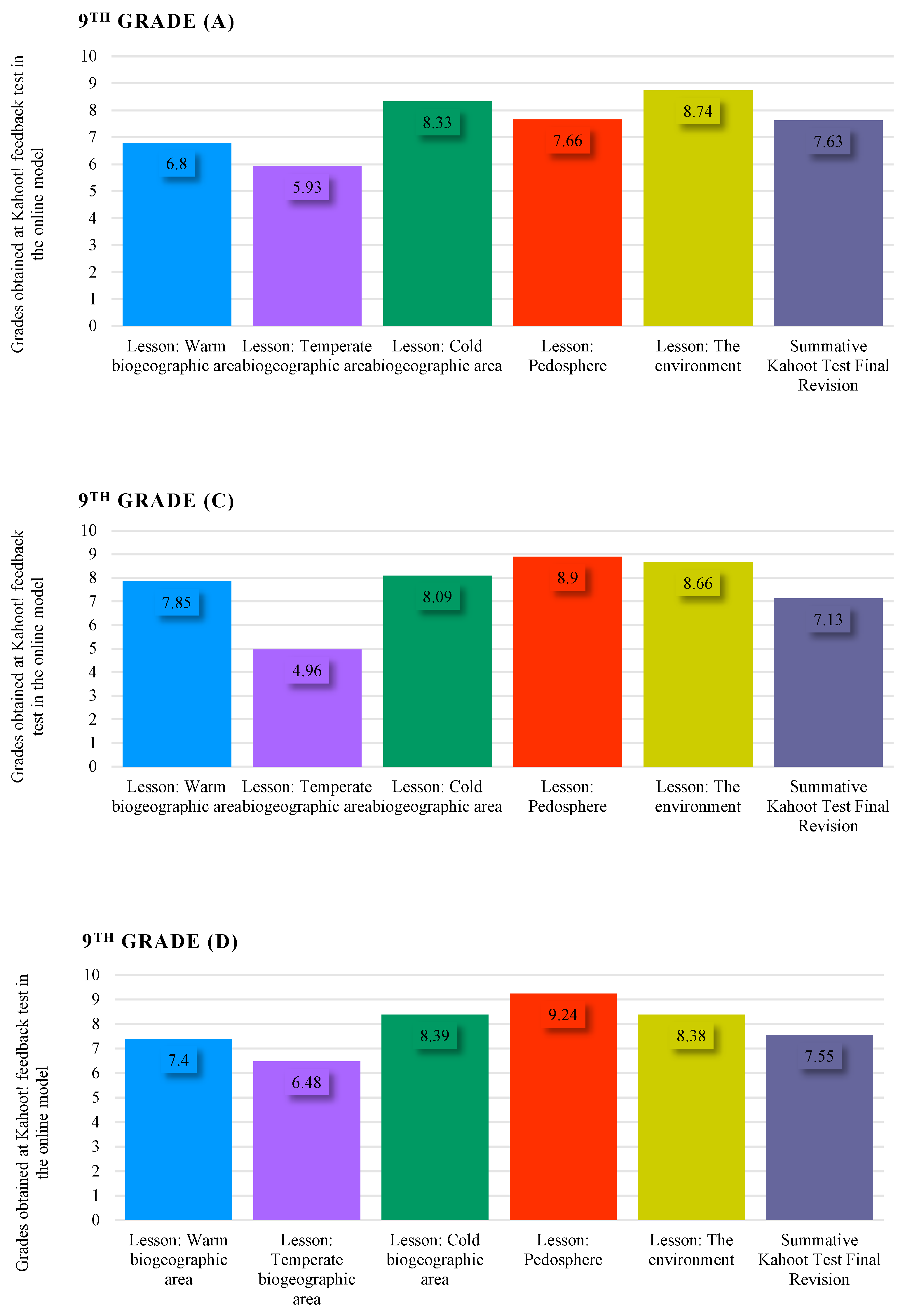






Publisher’s Note: MDPI stays neutral with regard to jurisdictional claims in published maps and institutional affiliations. |
© 2021 by the authors. Licensee MDPI, Basel, Switzerland. This article is an open access article distributed under the terms and conditions of the Creative Commons Attribution (CC BY) license (https://creativecommons.org/licenses/by/4.0/).
Share and Cite
Toma, F.; Diaconu, D.C.; Popescu, C.M. The Use of the Kahoot! Learning Platform as a Type of Formative Assessment in the Context of Pre-University Education during the COVID-19 Pandemic Period. Educ. Sci. 2021, 11, 649. https://doi.org/10.3390/educsci11100649
Toma F, Diaconu DC, Popescu CM. The Use of the Kahoot! Learning Platform as a Type of Formative Assessment in the Context of Pre-University Education during the COVID-19 Pandemic Period. Education Sciences. 2021; 11(10):649. https://doi.org/10.3390/educsci11100649
Chicago/Turabian StyleToma, Florentina, Daniel Constantin Diaconu, and Cristina Maria Popescu. 2021. "The Use of the Kahoot! Learning Platform as a Type of Formative Assessment in the Context of Pre-University Education during the COVID-19 Pandemic Period" Education Sciences 11, no. 10: 649. https://doi.org/10.3390/educsci11100649
APA StyleToma, F., Diaconu, D. C., & Popescu, C. M. (2021). The Use of the Kahoot! Learning Platform as a Type of Formative Assessment in the Context of Pre-University Education during the COVID-19 Pandemic Period. Education Sciences, 11(10), 649. https://doi.org/10.3390/educsci11100649







